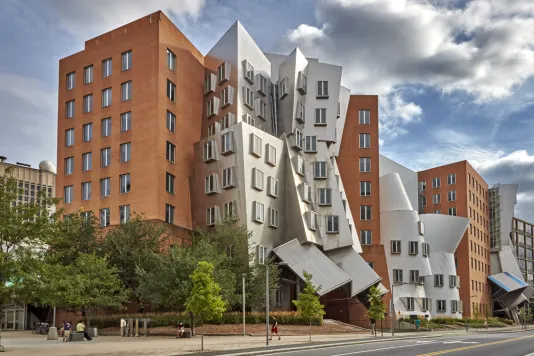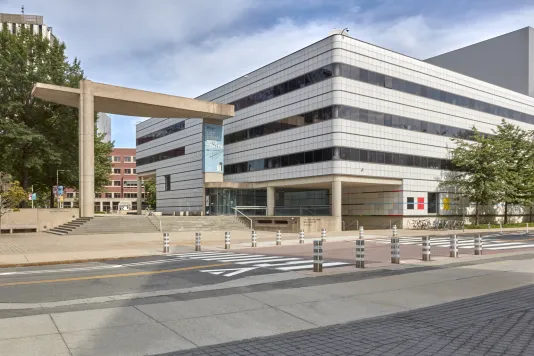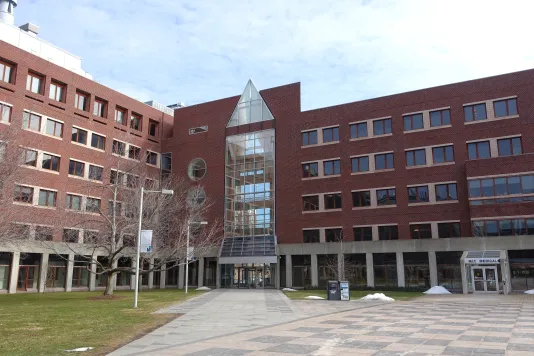Frank Gehry, Ray and Maria Stata Center, 2004. Photo by Chuck Mayer Photography.
Ray and Maria Stata Center, 2004

Arguably one of the most audacious, iconic buildings on MIT’s campus, Frank Gehry’s 713,000-square-foot Ray and Maria Stata Center (Building 32) is a cacophony of structural elements wedged, pushed, toppled, and fused into one another.
The steel-brick-aluminum amalgamation sits on the former site of Building 20, or the “Rad Lab,” the timber structure initially built as a temporary research facility during World War II, which became the site of pioneering developments in radar, microwave physics, and military technology. Though the Stata Center appears as a near 180 from the unassuming, worn-out nature of the Rad Lab, Gehry sought to maintain the ramshackle character of the original building’s innovation-dense environment. He did this by creating a space where community members and departments could bump into one another, convene in nooks and crannies, and work outside the confines of the modular, standardized lab and office spaces found in so many institutional contexts.
Gehry’s characteristic use of everyday, vernacular elements evoking scrap metal and other discarded materials manifests here in the presence of corrugated metal, plywood, and brick. At the same time, swatches of brightly painted red, yellow, and blue volumes infuse the building with a sense of play. The irregular forms of the structure also give way to a litany of outdoor spaces, including an amphitheater that looks out onto Hockfield Court quad.
Frank Gehry (b. 1929) was born Frank Goldberg in Toronto, Canada. After receiving a bachelor’s degree in architecture from the University of Southern California, he studied city planning at Harvard Graduate School of Design. He returned to Los Angeles and established his own practice in 1962. Gehry’s deconstructivist, eclectic, postmodern style has played out on scales ranging from small commercial and domestic projects—including his own home in Santa Monica—to large-scale cultural and institutional buildings worldwide. Notable works include Venice Beach House, California; Guggenheim Museum, Bilbao; Walt Disney Concert Hall, Los Angeles; Dancing House, Prague; and the Fondation Louis Vuitton, Paris.
Gehry has taught at a number of schools, including the University of Southern California, Yale University, Harvard University, and the Federal Institute of Technology in Zurich. He has received numerous accolades, including the Arnold W. Brunner Memorial Prize in Architecture, the Pritzker Architecture Prize, the Praemium Imperiale Award by the Japan Art Association, the National Medal of Arts, and the Gold Medal from the American Institute of Architects. Gehry lives in Santa Monica and works from his offices in Los Angeles, California.

